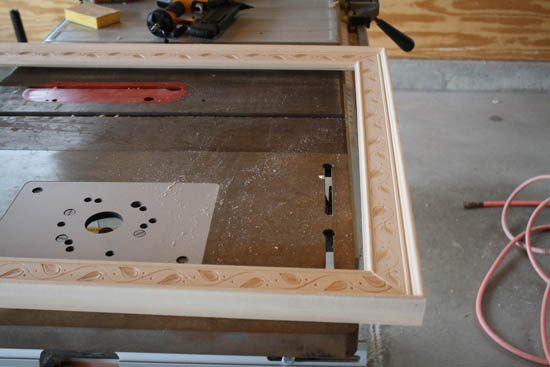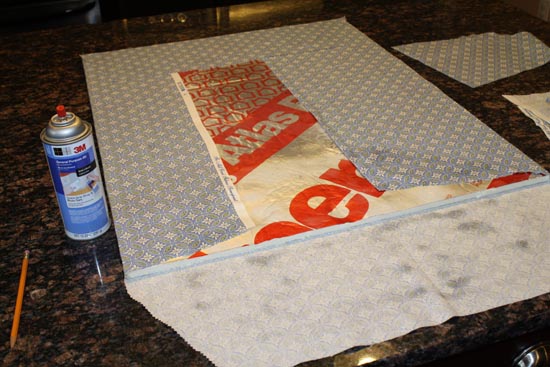Decorative Bulletin Board | Displaying Children’s Artwork
DIY Bulletin Board for Displaying Children’s Artwork
Our son is in Kindergarten this year and each day his backpack is full of artwork that he’s made during the days lessons. Recently he asked me if he could “nail” a picture to the wall so everyone could see it. A light went off in my head and I thought he and I could build a nice decorative bulletin board to display all of his artwork in our kitchen.
Building your own decorative bulletin board is fairly straight forward and a fun project for the family. Below are the steps we used to build our new bulletin board.

Materials You’ll Need
For this project we wanted a decorative bulletin board that would go with the decor of your kitchen. So we purchased some decorative moldings, a canvas weight fabric and a reddish toned stain.
Our design includes a pretty basic frame which supports a piece of foam board. The idea was to use a material (like foam) that would easily accept push pins and also work well with a cloth covering. Below is a list of materials that we used.
- Decorative Molding – We used a 3-3/4″ wide decorative picture molding (purchased at The Home Depot).
- 1×6 Pine Board – The pine board was used for the “back frame” which holds the foam board and plywood in place.
- 1/2″ Foil Faced Insulation Board – Foil faced insulation board is available at most hardware stores. Depending on the size of the bulletin board you’re going to build you can buy it in either a 24″ or 48″ wide piece (we used a 48″ wide sheet).
- 1/4″ Plywood – We used 1/4″ thick plywood under-layment for the back cover.
- Fabric – The sky’s the limit when it comes to fabric. We chose a heavy weight (almost canvas) fabric that should hold up nicely to the heavy use of a bulletin board. Be sure to buy a piece 6″ to 12″ wider and longer than the actual bulletin board.
- Spray Adhesive – We used spray adhesive to bond the fabric to the back of the foam board.
- Picture Hangers – In order to hang this heavy bulletin board we used some heavy duty picture hangers.

Build A Frame
The first step in building the decorative bulletin board is building a frame. Our bulletin board is 36″ x 24″ but you can build any size that fits your space. For this design we have a front frame (the decorative molding) and a rear frame which holds the plywood cover.
Rear Frame
The rear frame was built by ripping the 1×6 in half on the table saw. Next we cut a 1/4″ deep dado 3/4″ wide on the inside rear edge of the rear frame pieces. The corners were cut on 45 degree angles, glued and nailed together using our Bostitch Cordless Finish Nailer. As you can see in the photo the rear frame actually looks like a picture frame.
Note: The dado is sized to to accept the plywood cover. This also leaves 1/2″ that will create the pocket for the 1/2″ thick foam board.
Front Frame (Decorative Molding)
The front frame is built using the decorative molding that we purchased. It also creates the front surface that holds the foam board in place. As you can see in the photo above we fastened the front molding to the rear frame using small brads. The key here is the cut the molding so that the outside edge of the front and rear frames match.
If you look at the back of the completed frame you’ll see that there are now two pockets. The first pocket is created by the back of the decorative molding and the inside edge of the rear frame. Remember that edge of the rear frame is 1/2″ thick after we created the 1/4″ dado above it. The next pocket is the 1/4″ deep dado we cut which will accept the 1/4″ plywood back.
Before assembling the bulletin board we stained the frame with Sedona Red stain from Minwax. After applying two coats of stain we applied two coats of urethane to protect the finish.
Fabric Covered Foam Board
Next we cut out a piece of the 1/2″ thick foam board. The dimensions of the foam board were cut to be 1/4″ less than the length and width of the inner most frame pocket just behind the decorative molding. Foam board is best cut using a really sharp utility knife and straight edge.
Once the foam board is cut to size we attached the fabric using spray adhesive. Rather than spray the adhesive on the front of the foam board we sprayed the back. The key here is to be sure you pull the fabric VERY tight so the front has a smooth wrinkle free appearance (we also ironed the fabric first as well).
Final Assembly
 Assembling the bulletin board is very easy.
Assembling the bulletin board is very easy.
- First install the fabric covered foam board (it just lies in the pocket, no fasteners necessary.
- Install the plywood back cover. I used #8 – 3/4″ long wood screws along the edges.
- Install the heavy duty picture hangers.
- Hang On The Wall
Building your own decorative bulletin board is an easy, fun DIY project that the whole family can enjoy. We spent about $35 dollars on the project and had lots of fun working on it. I think it came out really great and the kids are excited to hang up their artwork.


















The biggest problem we’ve had with bulletin boards is that purchased cork rolls or tiles are too THIN to accommodate regular push pins. It’s like how the hot dog and hot dog bun people are rarely on the same page.
Had thought to put styrofoam under the cork. Using insulation board seems an ingenious solution. How is this board with “healing” after removing a pin?
In the new house we opted for magnet paint to create lots of magnetic “bulletin boards,” but apparently we needed far more coats than we used. The magnets stick but the bond is very weak. :/
Alison – So far so good, the nice thing is I can always replace the foam over time if need be.
Nice work man! Building childhood memories!